In September 1998, Tex Willer will be 50 years old. This character, halfway between a cowboy and a righteous gunfighter, is Italy's most beloved western hero. He has outlived his graphic creator, several different formats and editions, narrative experiments, and all the serializations of western comics serials born before, with, and immediately after him. To go back over his origins and career again is like jumping on an old wagon and rediscovering a mythical America, a fictitious, stolen, and manipulated object of desire situated in the land of Italians' collective imagery between nostalgia and eternal boyhood.
Giovanni Luigi Bonelli and Aurelio Galleppini
It was September 1948. The age of fascism and war had just died away and in Italy people woke up from that long nightmare with a desire for reconstruction and a longing for America. After years of an ideology that regarded "America" as an evil temptation towards freedom and democracy, Italians could go back to an American dream the way this was embodied in movies, books, comics and heroes. Tarzan had eluded the fascist censure by hiding under the costume and name of the German "Sigfrido" and people stared at their freedom as at a never ending prairie. Perhaps Europe looked a little like the West with all there was to build and recreate, but here the scenario was somehow depressing, there it was astonishing. Peering out of the ruins of Europe, people could go back to the images that the war had swept away, that of an almost untouched land, which was being transformed quickly through the bad and good energy of free men. Like the men of the Old West, Italians felt they had to reinvent entities as well as identities. It was a time in which what counted the most was each man's creativity. For once, Italy didn't look like an old society forced into a stratified and fixed order, but rather like a place where people could change themselves and change their society as well. Another reason for the western's appeal in postwar Italy may well have been that the ideal American revealed intolerance towards constrictions and authority, a sentiment that post-fascist Italy certainly shared.
|
|
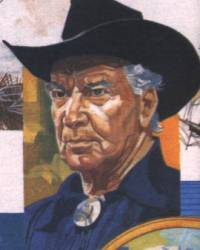
Giovanni Luigi Bonelli
drawing by Ferdinando Tacconi (c)
| | |
|
Giovanni Luigi Bonelli, one of the leaders of the western revival in Italy, says that by creating Tex Willer he gave form to people's ideal hero: "People hate the arrogant military, the powerful man, the banker. People hate power, or as we say nowadays, 'il palazzo[.]' We are all anarchist, rebel, bothered by thousands of problems" ["Conversazione con Bonelli"]. And to further free his audience from the memory of the fascist cultural "heaviness", Bonelli avoided the long descriptions of Zane Grey and gave to his stories "rhythm, action and dialogue" typical of the narrative tradition of adventure. ["Conversazione con Bonelli"].
In a little apartment on the via Saffi, Milan, Tea Bonelli had organized his little publishing house specializing in comic books. She shared the apartment with his son Sergio, and Aurelio Galleppini, a graphic artist. G.L. Bonelli, who had started writing novels and scripts for comics in the 30's, was one of the first Italian editors to go back to comics after the war. As early as 1946 he was publishing the magazine Cowboys with editor Fernando De Leo ["Spaghetti Wilderness"], and two years later, was already releasing the western strips I Tre Bill, Yuma Kid, Hondo, and Rio Kid. In September (1948) he sent out to the newspaper kiosks of Italy the first issue of a new western comic which was destined to become a cult classic, probably the most long-lived western comic of all time.
The first issue of the "Collana del Tex" ("Tex collection") was titled "Il Totem misterioso" ("The mysterious Totem"); its cover presented the image of Tex, a cowboy, on a reared up horse, and three bandit-like men sheltered behind some rocks, holding guns in their hands and fear in their faces. Tex was regarded as a B comic by its creators who directed their best efforts towards Occhio Cupo (Dark eye) which featured a hero of the North America in the 1700's. Galep would illustrate this comic during the day and reserve the nights for Tex, but the results were quite different from Bonelli and Galleppini's expectations ["Conversazione con Galleppini"].
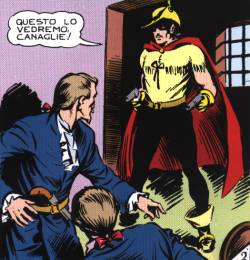
Reprint of "Occhio Cupo". Original b/w (c)1948 SBE
|
The hero
The first episode opened in the middle of a chase. A caption on the left margin described the following image:
In one of the wild gorges of the Rainbow Canyon, Tex Willer is resting after a long ride which brought him beyond the Texas borders, when, all of a sudden, a series of shots echo not too far away [note I].
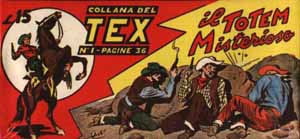
Tex "striscia", first number (c)1948 SBE
|
With the aid of a pair of binoculars, Tex spots a young Indian girl riding a horse and a group of men chasing her. Recognizing a certain Coffin and his lackeys, Tex decides that the girl must be in trouble and that he must take care of her. Speeding his horse down the gorge, he quickly reaches the young Tesah who, hearing his name, exclaims: "Tex Willer, the lonely avenger?" But Tex reassures her by saying that he kills only those who deserve it, then he asks the girl to tell him her story. It turns out that her chasers are after a medallion, the "sign of the totem", which can lead to a hidden treasure sacred to her tribe, the Pawnee. The story unfolds and reveals a universe larger than that of the mere western tradition. On the one hand, there is the cowboy stereotype: "Wrapped in a cloud of whitish dust, the sound of horses galloping mixed with excited shouts reaches the ears of a lonely rider crouched down the rocks of the Rainbow Canyon" [Introduction to "Il Totem misterioso"].
On the other hand, there is the dream of long ago civilizations whose treasures lie hidden in vaults, reachable through secret passages that open at the touch of the right button. In fact, after several breathtaking moments, Tesah and Tex reach the place of the "Talking Rock." Tesah leads Tex to the sacred treasure after opening a wall in the cave by pulling a metal ring. It is immediately clear that Bonelli conceived the West as a place for legends. While employing many stereotypes and details pertaining to the western genre, he transformed this ideal place into a frame for a number of flamboyant adventures drawn from all kinds of literature, movies, myths and from history itself. The Indians become the source of mystery and magic, a symbol of friendly or evil otherness with which is possible to play in many different ways. The land, a wilderness embodying the fantasy of a prehistoric world, is filled with the secrets of all the strange peoples who lived long ago as well as in the present of the narration. It seems to assist to a migration of the imaginary. People went west, and whatever different, exotic and uncanny belonged to their history and myths went along with them.
|
|
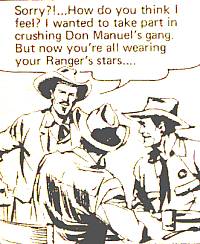
Texas Rangers! (c) SBE
| | |
|
Following the fashion of the time, as conveyed by movies and novels, Tex was first a lonely avenger who - as the reader learns over the many years of the comic's existence - left his father's farm in Texas after both his father and his brother were killed by a gang of bandits ("Il Passato di Tex" n.83/85). Tex seemed to be destined to be a loner and outlaw, possibly a follower of the Lone Ranger, but Bonelli changed his idea quickly. Within the first three episodes Bonelli had already changed his hero into a Texas Ranger, and later on into an honorary Navaho leader with the name of Night Eagle ["Tex e il sogno continua"].
Tex's substantial characteristics however were unchanged. He remained the fearless hero with a strong aversion towards the agents of violence and crime and an inclination to defend every victim of greed, of evil, and of unjust wars that happened to be in his path. Over time, the character, although not as popular as other Italian westerns of the time (Capitan Miki, Il Grande Blek) conquered the affection of both its readers and authors. The latter grew so fond of it that they decided to change the format of the comic strip into that of a comic book. The larger and thicker format brought about an explosion of Tex's popularity. The enterprise of Bonelli and Galep now called for some help. Other illustrators soon supported Aurelio Galleppini (Galep), as well as other writers-including his son Sergio, alternating their work with Bonelli's. As a result, Tex, who G.L. Bonelli wanted to be mysterious and without a past, was given a complete biography by Sergio Bonelli ["Tex e il sogno continua"]. Finally, almost two decades after his "birth", Tex sat with his friends around a campfire and told the story of his life ["Tex e il sogno continua"]. Most of the important events of Tex's life and transformation were told in the first 3 years of his editorial life, while for the remaining 47 years Tex and his pards seem to have lived through infinite variations of the same scheme ["Il Caso Tex"]. Lilith, Tex's Indian wife, died many years ago but Tex is still faithful to her memory; Kit who quickly reached his teens, is forever banned from adult age; whereas Tex continues undisturbed to beat up evil-doers and win all his battles.
However, under the surface a lot of little changes took place both in his character and aesthetic features as well as in his adventures. Beneath the noisy and excited humor of his feats, the readers can detect the little alterations brought about from time to time by different illustrators and writers. It is as if each episode could be read at multiple levels, and the real action be found more in a sort of metaphysic of the hero than in well-designed plots.
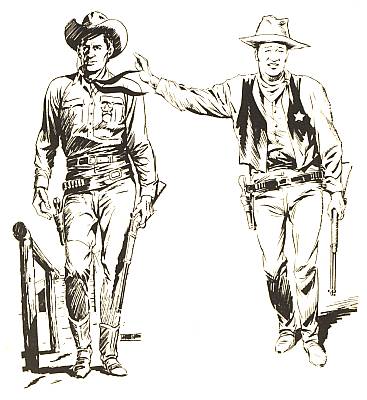
Tex and "The Duke" John Wayne (c)
|
If courage and skills allow the hero to satisfy his thirst for justice and to survive his perilous enterprises, these elements alone would prove insufficient whenever the hero encompasses the borders of his familiar world. From the very beginning Tex shows an open mind and a deep sense of respect before all kinds of different peoples and practices. The difficult task of adapting and understanding the new is largely accomplished through friendship ["Io sparo positivo"]. Like many other comic's heroes of the West he soon ceased to be alone and joined the "company of men."
 |
next page: "Characters and Plot"; "The source"
|
|